UPDATED: CHESTER Road was closed after the walls of the former historic Ship Inn collapsed earlier this afternoon during housing development works at the site.
Demolition work was taking place on the site to prepare it for a housing development, with plans in place by Elan Homes to develop 14 four and five bedroom houses.
The building, which was also previously the Ship Inn pub, and more recently the Jahan Indian restaurant, has not been in use for several months.
Police confirmed all utilities had been disconnected as demolition work was taking place to prepare the site for a housing development.
The road was completely closed between The Stag and Walton Lea Crematorium causing lengthy traffic delays but has now re-opened.

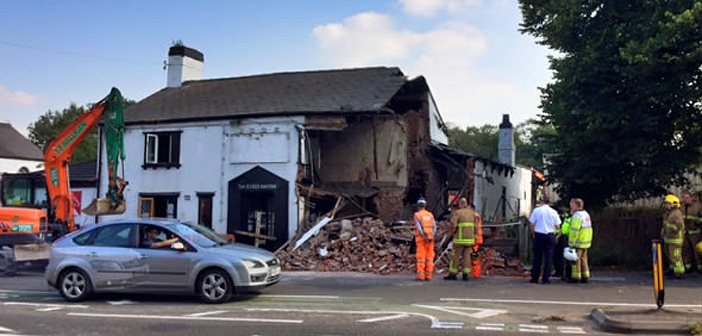
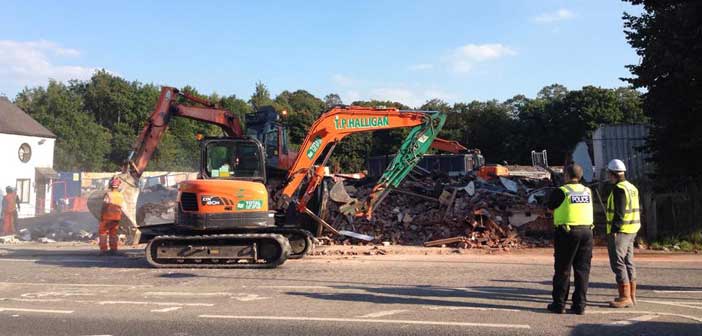
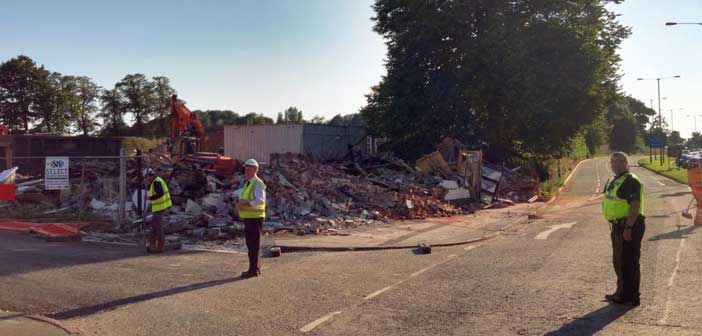
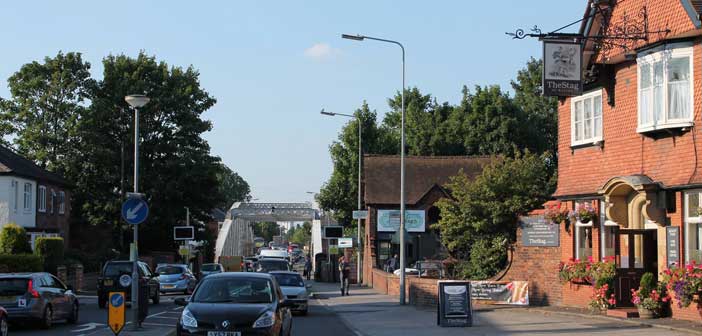


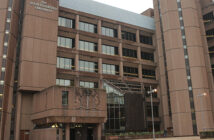
17 Comments
All lanes completely open when I was at the Stag 30 mins ago. Well if you can class Chester Road as being ‘open’ as it’s completely gridlocked all the way down towards town centre due to the accident on the motorway.
Another historic building gone for more bland housing estates, car parks and retail parks. No wonder there’s no character left in this town.
It’s very strange how most of the Listed Buildings in Warrington get knocked down or set on fire. And nobody is accountable for any of this.
Yes it is very strange that listed buildings in Warrington can ‘crumble’ or get set on fire, very ‘conveniently’ for proposed developments, without either the police or the fire services or our borough councillors noticing the link. Were English Heritage given a chance to survey this building and to give their views on whether or not it should be demolished or restored? – I doubt it.
As with Mr Smiths – which didn’t appear to be beyond restoration – the bulldozers went straight in.
Its not been used for over 2 years now …. was empty when I visited at the end of 2013.
It was very recently the Jahan Indian restaurant certainly until midway through 2014. We should all be concerned, with the less than reassuring record of our local planning department that this sort of thing, as Sha has commented above, happens far too often to be regarded as “accidental”.
It wasn’t listed, not qualifying under “Buildings erected after 1840 may be listed where they are the best examples of particular building types; only buildings of definite quality and character are listed.”
Usual challenge – name more than half a dozen listed buildings in Warrington lost in the last 25 years….
It really is nonsense to suggest that the Council would have a policy for “locally listed” buildings (when not all Councils do) advocating their retention, that the developers would go to the trouble and expense of starting work to convert the building, then get a willing contractor to cause it to collapse.
Have you any information re the history of ownership of the building Steve? Was it in the same ownership prior to ‘conversion work’ and at time of demolition?
Perhaps someone has/will put a good offer in?
Doesn’t bode well for Elan Homes if their structural engineers forget to secure the exterior walls before making internal changes! This was not a listed building but planning permission was conditional on preserving the character of the property and incorporating it within the development. Upon semi collapse police told them to make the structure safe… so the did by demolishing it to rubble within an hour. Draw your own conclusions.
The planning documents for this scheme, in the Reserved Matters for this application (ref: 2014/23334) state: “Site included existing former Ship Inn public house a locally listed building (sic)…”. It is the job of the conservation officer to make sure historic (not necessarily listed – my emphasis) buildings of the borough are looked after. Moreover, the 106 agreement – a legally binding document – for the scheme would comprise “the erection of 11 detached dwellings and the conversion of the former Ship Inn and adjacent outbuildings into three dwellings…” It is reasonable therefore to conclude the conversion of existing buildings was a planning condition and that the conservation officer should have ensured compliance. Since the RMs document also states one of the prime purpose of the 106 agreement is “to enable Warrington Borough Council to adequately control the development and to minimise its impact on the amenities of the local area”
It’s also worth pointing out an earlier application by Elan Homes (ref: 2006/09704) for this site “proposed 15 new detached houses…” That it was refused seems to be purely academic now. But it does put into sharper context disingenuous Steve Parish’s comments above.
I entirely agree with David Hazeldine’s comments above.
apologies for an error in last para of my previous posting it should read “But it does put into sharper context Steve Parish’s disingenuous comments above.
I entirely agree with David Hazeldine’s comments above.”
Once again apologies for the error.
“Disingenuous”? For not being a conspriacy theorist? As I understand it, the contractor was working on plasterwork when he noticed movement and got out. A structural engineer was called but the building started to collapse. For a site close to the highway, the Police felt demolition was necessary for public safety The developer was always willing to retain and convert the pub, so it’s unfortunate but not suspicious.
Steve, what does “A structural engineer was called but the building started to collapse” actually mean?
Did a structural engineer actually survey the building prior to demolition or not?
If not, what kind of building qualifications does the police person/s who ” ‘felt’ demolition was necessary for public safety”, have? Or…On whose professional advice did the police person make their decision?
Also, you wrote, “The developer was always willing to retain and convert the pub, so it’s unfortunate but not suspicious”. You write as though these are statements of fact but they are merely your personal opinion.
I have no idea what “advice” the police took, or whether they’d have said the same if the building was statutorily listed. Just pragmatically, how long do you want Chester Road closed, causing traffic chaos, for the sake of a building that wasn’t important enough to be listed? But looking at that top picture, I’m not sure you’d find an engineer happy to enter the building to carry out a survey.
Unless you have evidence to the contrary, the developer’s willingness to retain the building is a matter of record in the planning application. I’m not sure whether the 2006 application retained the pub, but it was turned down because there was no need for more housing! I can’t see whether the present developer was involved – it was a package proposed by Greenalls after thne distillery fire.
Steve, in one post you say “a structural engineer was called” but you didn’t answer my question, “Did a structural engineer actually survey the building prior to demolition or not?” You say ” the Police felt demolition was necessary for public safety” but you have no idea what “advice” the police took. You seem to think the police decision might have been influenced if it was statutorily listed. I can’t understand why the police decision was not influenced by the fact the building was part of a controversial, planned development – as there are so many ‘accidents’ and ‘fires’ in such buildings. I personally would have expected the police to insist on a qualified survey to determine the cause of the building’s ‘collapse’ – rather than order the demolition and destruction of any evidence. Also, ‘looking at that top picture’, I see that T P Halligan’s demolition team and machinery have arrived at the scene. Was the picture taken prior to or after they had started work? I find it extremely hard to believe that any building could, without apparent cause, just disintegrate to the level shown in the photo. Also, in the time it must have taken for Halligan’s to travel from Trafford Park surely a local surveyor could have got to the scene?
You say, “the developer’s willingness to retain the building is a matter of record in the planning application”. All that is evidence of is that it was part of the conditions to obtain acceptance. How often do developers obtain planning permission, then later apply for changes to the original plans? Neither you nor I could possibly know for sure the developer’s intentions. Whatever, a thorough investigation re this buildings ‘collapse’ should have been made.
It’s very interesting if you check out Google street view, the image is only taken about 1 week before the ‘collapse’ – you can very clearly see 2 large cracks on the building – strange how Elam homes didn’t spot this and secure the walls. I wouldn’t want their structural engineers working on my house.
The risk assessment for the proposed conversion work on a locally LISTED building should make interesting reading. Especially so since the Heritage Statement with the application in a reference to the Ship Inn states:
“5.3.2 The former Ship Inn is a Locally Listed Building within the study site boundary, considered to have architectural and historic interest and is of local significance. No impacts on this significance, or appreciation of it are anticipated, as it is proposed to retain the building. Whilst development of the site to the rear will bring visual changes within the setting of the Ship Inn, setting is considered to make a neutral contribution to its significance.” No mention of any cracks or other deficiencies that might affect or impact on the intended conversion.